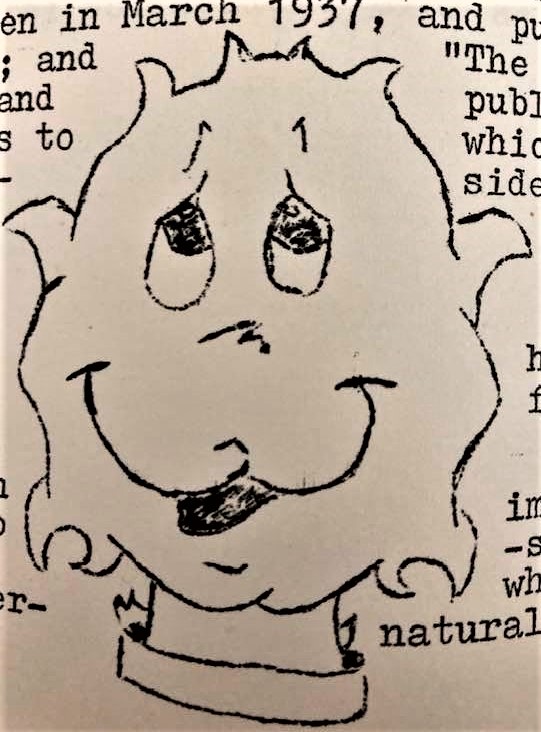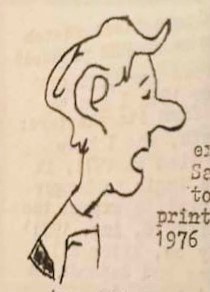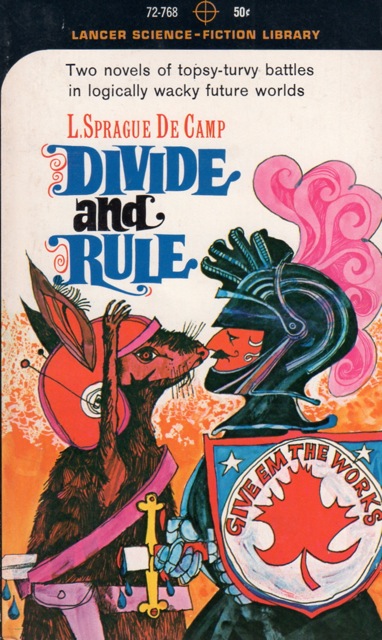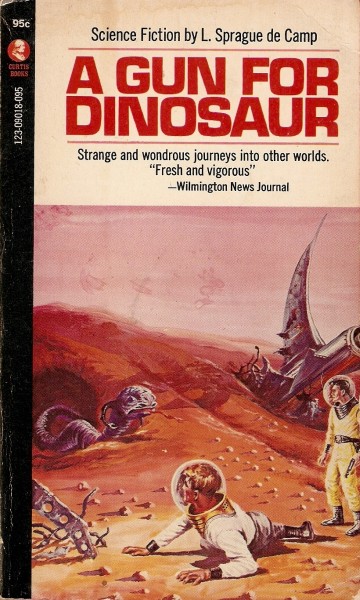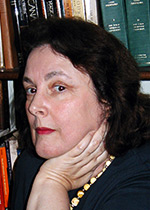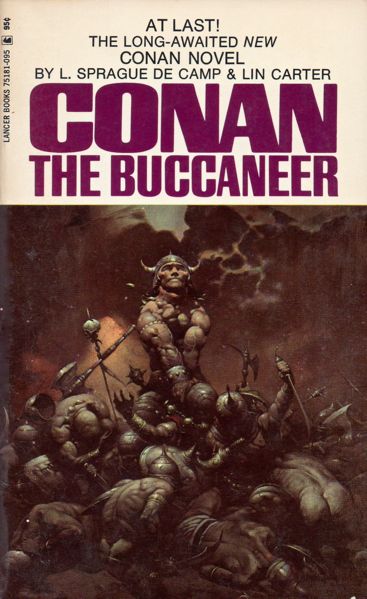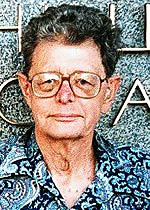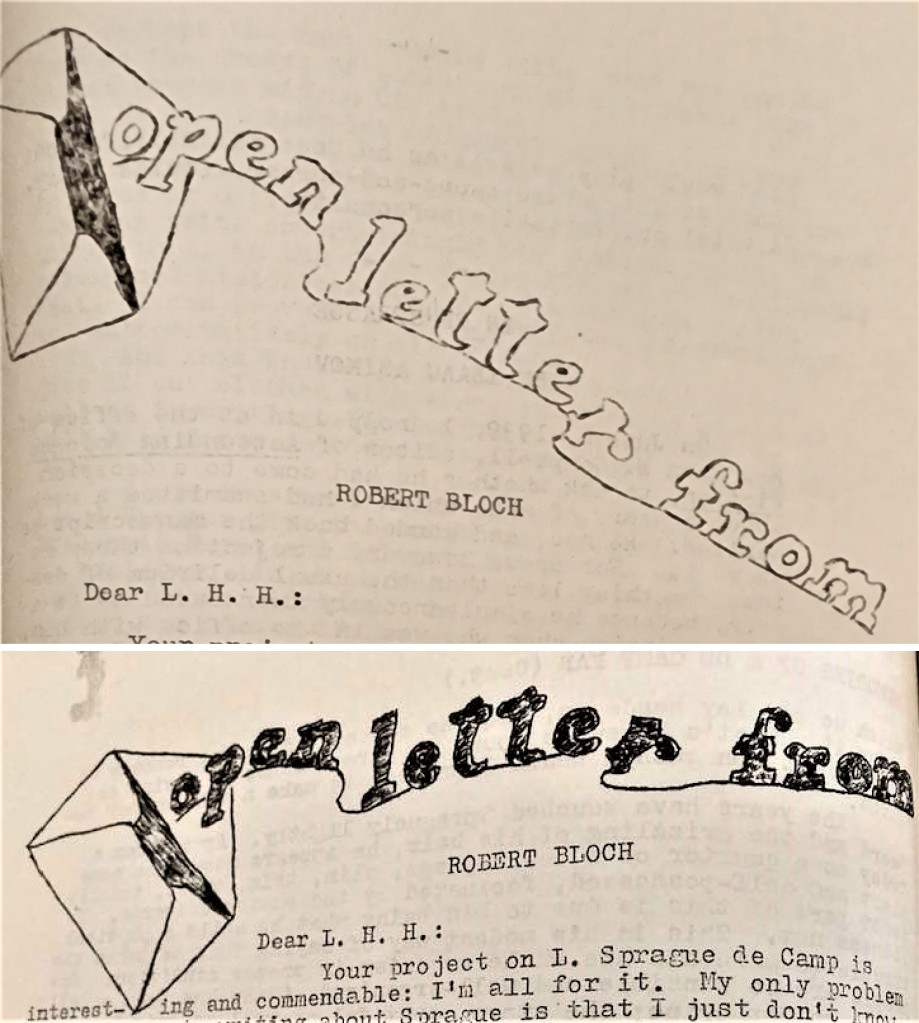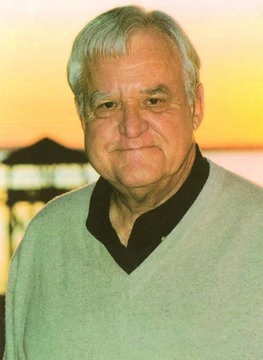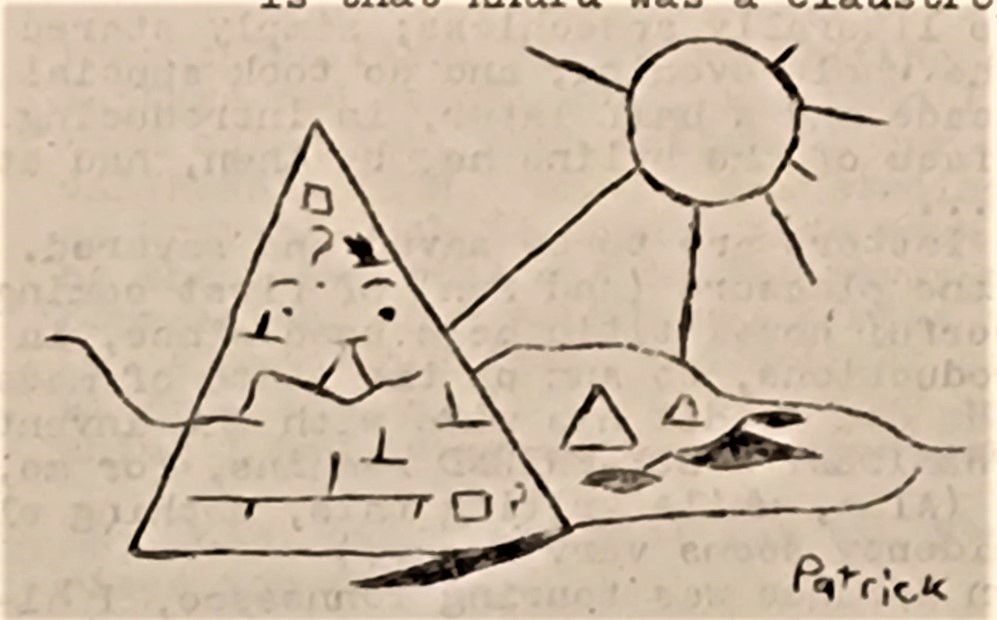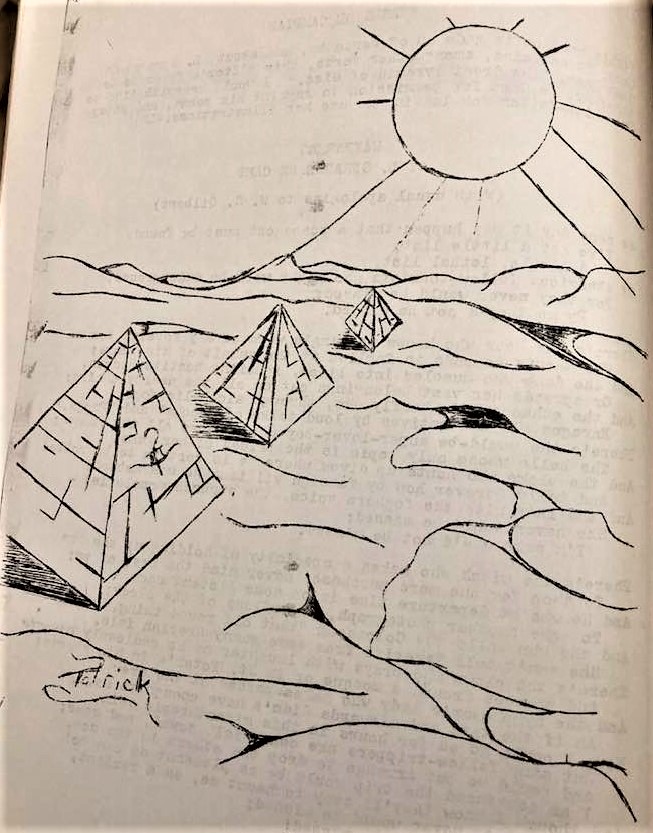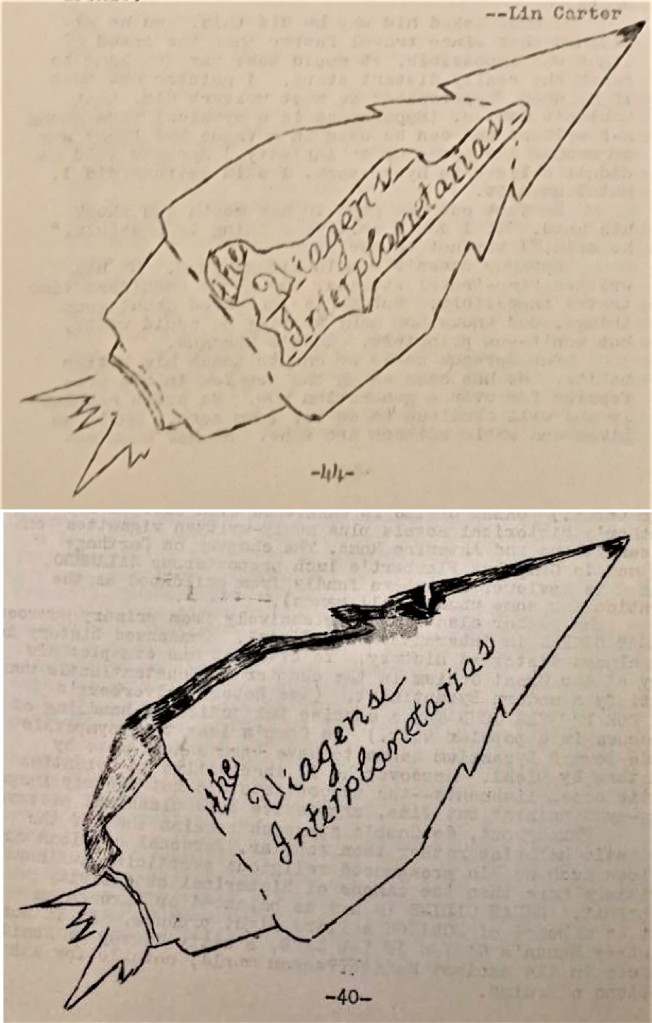by Brian Kunde
Today’s highlight is Pusad Revisited, a de Camp-centric fanzine of the mid-1970s. This one’s obscure enough to warrant a deep dive. It was the brainchild of editor Loay Howard Hall, already encountered in this review series as author of the story annotations in Laughlin and Levack’s De Camp: An L. Sprague de Camp Bibliography (1983). I quote what I wrote there: “Loay H. Hall (b. 1949) [is] a de Camp uberfan from back in the day (the day being the 1970s and 1980s), who published two editions of Pusad Revisited (1974 and 1977), the first … de Camp-focused fanzine. … He also authored a handful of short stories that appeared in various small press periodicals, and a fair number of critiques for Science Fiction & Fantasy Book Review. A few years back he resurfaced briefly as a contributor to Gary Romeo’s late, lamented Yahoo group, d for de Camp.” To which I might as well add that he was also a member of the Lovecraft-related amateur press association The Esoteric Order of Dagon in the late 1970s and early 1980s, to whose mailings he contributed at least four issues of his fanzine Ko-Song.

Bibliographical data on Pusad Revisited is scant, partly because Hall did not make it easy for bibliographers. The first issue is unnumbered and undated; the second numbered but also undated, the covers are identical, and the content largely shared. Usually reliable authorities like OCLC or the Harry Ransom Center of the University of Texas at Austin estimate the issue dates, and genre sources are unhelpful. The Internet Speculative Fiction database does not cover the title, nor do Laughlin and Levack—an odd omission, since Hall, as their collaborator on their bibliography, could have provided full details. L&L reference PR only as a publication in which a few de Camp poems had appeared—and they miss one! No source I have seen provides a full list of contents for either issue.
To learn what’s in this obscure but intriguing item of de Campiana, we need to go to the source—and right there, we have a problem. Pusad Revisited is hard to find. Copies sometimes turn up online, but by and large, the supply has dried up. It was never easy to acquire both issues, thanks to those identical covers, which confused buyers and sellers alike. Fortunately, we at spraguedecampfan have the set, and can light your way through what would otherwise remain obscure. Here is what Mr. Hall produced for an earlier and more fortunate set of de Camp fans.
OVERVIEW.
Physically, Pusad Revisited is like other fanzines of the 1970s, composed of mimeographed pages stapled between more professionally produced covers. The interiors have a comparatively cruder look. That’s not to knock the mimeograph, which was in its heyday a decent technology for cheaply making lots of copies of things. My own junior high’s school newspaper was produced that way.
COVERS.

The front covers of both issues have the zine title, PUSAD REVISITED, in all caps in a box at the bottom, beneath a much larger box boasting a greyscale reproduction of a painting showing L. Sprague de Camp in portrait over the climactic scene from his classic short story “A Gun for Dinosaur.” The terrifying Tyrannosaurus enters at left, hapless sahibs Courtney James and August Holtzinger milling at its feet in confusion, while safari leaders Reginald Rivers and Chandra Aiyar, rifles ready, dash to the rescue from the right. The author from whose mind this has sprung broods in the foreground in suit, tie and heavy glasses. It’s a good rendition, maybe not pro level, but not far from it. The cover of de Camp’s 1996 autobiography Time and Chance, similarly composed, might well have been inspired by it. The piece is signed “Jim Garrison ’73.” Garrison, also known as James D. Garrison and J. D. Garrison, was a successful long-time fan artist, whose work appeared in zines amateur and semi-professional from 1971 through at least 2016. The ISFDb has a long list of his artistic credits, and points to a couple websites of his work, both, alas, defunct.
The back covers have a full-page cartoon offering a lighter take on the same subject. Another generic Tyrannosaur stands over the discarded wrappings of its Christmas present—a rifle, borne in its arms. “Oh boy,” the creature exclaims, “just what I always wanted!” The caption? “A GUN FOR A DINOSAUR.” This misreading of the story title is quite common, and apt for such humorous treatment. The art, by Brent Purdom, is clean and effective. I know nothing more of this artist.
PRELIMINARY MATTER.
Inside, the content of Pusad Revisited’s two issues is largely duplicative. Aside from brief notes by the editor, there is a core group of fifteen pieces by various contributors common to both issues, while seven pieces are unique to the first issue, and seven others unique to the second. Arrangement of material in the first issue is haphazard, aside from a book review section; the second issue sorts its content into sections by type. I am reminded of de Camp’s own poetry collections, which similarly mixed and rearranged shared and unique material. This being the case, discussing the content of each issue separately would be too repetitive. Instead, I will address each contribution once, keying each to where it appears in the two issues. The presentation is topical, in an arrangement similar to that of PR2.
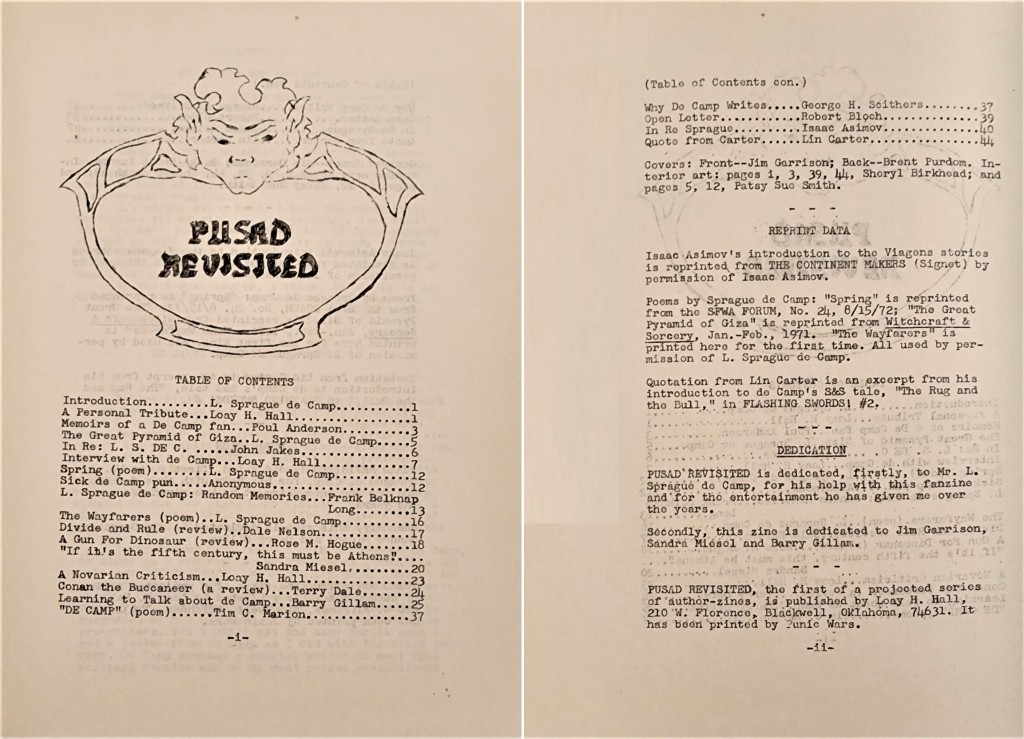
Each issue begins with preliminary matter and a table of contents. PR1 has two preliminary pages, numbered i and ii. Page i is headed by a title illustration incorporating the words “PUSAD REVISITED” within a shield topped by the head of a faun—a typical specimen of 70s fanzine art; roughhewn, pleasant, and not necessarily related to the text. The art is credited on page ii to Sheryl Birkhead.
The Table of Contents follows, continuing onto page ii, listing, in order of appearance, the pieces included, their authors, and the page numbers on which they start. Titles of some contributions are truncated or otherwise at variance from those appearing on the pages referenced. A few are inadvertently omitted from the table.
Beneath the Contents are art credits, adding interior artists Sheryl Birkhead and Patsy Sue Smith to the cover artists already encountered. Sheryl Lynn Birkhead (b. 1946) is a fanzine editor, writer and artist whose work has appeared in various zines from 1969 into recent years. She developed artistically as time went on, being nominated for the Hugo Award for Best Fan Artist in 2001 and 2002. In her day job she is a veterinarian living and working in Maryland. Birkhead’s art in PR is serviceable without presaging her later acclaim. Patsy Sue Smith, later Patsy Sue (Smith) Sutton, is a connection of Hall’s. In his segment of the dedication in Laughlin & Levack he acknowledges her among various family members “for being there when ‘Unc’ needed her and for never forsaking him during ‘the hard times.’” Her PR art, signed as “Patrick,” is of amateur quality.
Next come credits for previously published pieces, designated “Reprint Data,” citing the sources of the Asimov piece appearing later in the issue, the issue’s three poems by de Camp (one, the editor notes, being original to PR1), and the quotation from Lin Carter that concludes the issue. All but the Carter piece are stated to be used by permission of the original authors.
Then there is a dedication to “Mr. L. Sprague de Camp, for his help with this fanzine and for the entertainment he has given me over the years,” and to fellow fans Jim Garrison, Sandra Miesel and Barry Gillam, all of whom contributed to the issue.
The preliminary matter concludes with a publication statement declaring the fanzine “first of a projected series of author-zines,” identifying the publisher (Loay H. Hall) and his address, and the printer (“Punic Wars”). There is no publication date, although, to get ahead of myself, it will later be provided in Pusad Revisited #2 (which itself fails to give its own publication date) as 1974. At this stage it appears that no second issue was intended; rather, PR was to be a one-shot that Hall planned to follow up with similar zines focusing on other authors. He didn’t, and PR2 would be the only follow-up. Speaking of which…
In PR2 the preliminary matter consists of one unnumbered title/contents sheet, recto printed, verso blank. Birkhead’s PR1 illustration, cut down to just the faun’s head, again tops the page. And again a publication statement, dedication, credits, and table of contents follow.

In the publication statement, Hall tells us “PUSAD REVISITED #2 is a special L. Sprague de Camp tribute, edited and published by Loay H. Hall, … available for $1. 50 per copy or for trade of one of their zines to fellow fanzine editors.”
The dedication this time is “to four very important individuals … the gentleman whose writings inspired it, and who so kindly permitted me to reproduce some of his verse herein: Mr. L. Sprague de Camp; also, … to my fellow Decampian and good friend Phillip Sawyer, and to Terry Lee Dale. And lastly, but certainly not leastly, … in memory of my late sister, Dorothy L. Steele, who died December 27, 1976.” This date, coupled with references later in the issue to forthcoming de Camp works known to have appeared in 1977, allows us to safely assign the issue to early 1977.
The credits, again designated reprint data, source several pieces included in the issue, including its (now) six poems by de Camp (with “Wayfarers” sourced to PR1) and the piece by Isaac Asimov. Hall doesn’t always get his sourcing right, as in some instances his citation was not in fact the original source of the material. From this, you might assume he did a slipshod job. But not being blessed with the bibliographical resources we have today, he did as well as he could. Moreover, bringing together the material he provided, much of it from spec fiction professionals, was a remarkable achievement.
There are no art credits this time, which is unfortunate, as the issue contains a lot more art, mostly in the form of “grotesques” (small, incidental, weird heads) interspersed here and there about the text. Birkhead may have contributed some of these—her faun’s head shows that she was capable—but signatures show at least two other artists involved, Al Sirois and a certain “M,” both of whom we will discuss as we encounter the art. Birkhead’s PR1 pieces are also reprised, in some instances with slight alterations, and Patsy Sue (Smith) Sutton, a.k.a. “Patrick,” is represented again as well, with redoes of her work from the first issue.
The table of contents, more cramped this time, fills the remainder of the page, listing, in order of appearance, the issue’s contributions and their authors, but unlike in PR1, without page references. As before, the title listings are occasionally shortened, and a few pieces omitted from the table—including, oddly enough, one of the de Camp poems sourced higher up on the same page.
MAIN CONTENT.
Following the preliminary pages, PR1 has 44 numbered pages of content, and PR2, 40.
INTRODUCTION AND PRINCIPAL ARTICLES.
Not a category Hall uses, but each issue has at least two long articles not easily classed with the remaining content, some near the beginning, some appearing later on. It seems convenient to discuss all of these first.

“Introduction” (L. Sprague de Camp). PR1: page 1; PR2: page 1.
Appears in both issues (in PR2 beneath a bit of uncredited art—a stylized leaf—and the letters L. S. DE C.). Four paragraphs, amusing but slight. De Camp notes he was “vastly flattered” at Hall’s intention “to put out a one-shot fanzine devoted to me,” but “put on the spot” when asked to write the introduction. Torn between agreeing with “the nice things … said about me” (and appearing “an insufferable braggart”) and “confess[ing] all my sins and shortcomings” (and getting judged for them), he concludes “the safest course … is simply to admit that … WORDS FAIL ME.”
“Interview with Mr. L. Sprague de Camp” (Loay H. Hall). PR1: pages 7-11; PR2: pages 2-6.
Appears in both issues. Hall’s interview of de Camp covers various topics, including when and where de Camp was born, where he went to college, when he became interested in writing, his first professional pieces, his definition of science fiction, the chronological placement of Rogue Queen in the Viagens Interplanetarias series (undetermined, but roughly the same period as the stories in The Continent Makers), when the out of print Viagens novels would be reprinted (after the then in-progress Lovecraft biography), why he stopped writing science fiction after the mid-1950s, his opinion of “New Wave” SF (mixed), how he regarded Roy Thomas’s comic book adaptation of “A Gun for Dinosaur” (positively), how he met Fletcher Pratt, how they collaborated, which had the idea for the Harold Shea stories (Pratt), which stories make up the Pusadian series, whether any more “Jorian” stories would appear (yes), how long it takes to research a historical novel (a few weeks!), which of de Camp’s books is his favorite (usually the last he has written), his advice for aspiring writers, and how he envisioned his future.
Accompanying the piece in PR2 is a grotesque, the head of a smiling creature in a collar, vaguely Seussical, at the bottom right of page 2.
PR2 updates the interview, generally by footnote, and contains a few typos not present in the original version (a frequent defect in the repeated material). The interview is extended to address the criticism of Lovecraft: A Biography (1975), which had been published in the interval between the two issues.
“The Modern de Camp” (Phillip Sawyer). PR2: pages 6-12.
Appears in PR2 only; the first new piece in that issue. Phillip Sawyer, like Hall, was not just a fan but a long-time friend of the de Camps. Both would be lured back into de Camp fandom in the mid-2010s by Gary Romeo, who invited them to participate in his then-active Yahoo discussion group d for de Camp. Hall participated for only a short time, but Sawyer persisted, and when Yahoo pulled the plug on its groups he transitioned to become an active contributor to the facebook group L. Sprague de Camp- Enchanter of the Quill and Gary’s spraguedecampfan blog. Sawyer has shared with both groups his extensive archive of de Camp letters.
In a prefatory note, Sawyer notes the article “is made up largely of quotes excerpted from letters from L. Sprague de Camp to Mr. Sawyer over a rather lengthy period and some of the topics discussed, therefore, are dated. This piece printed by permission of Mr. de Camp. Copyright © 1976 by L. Sprague de Camp.” A second prefatory note is more on the order of a general introduction. Topics covered in the article include: The Middle East; On Competing Political-Economic Systems; TV Violence, Gun Control, and Crime Control; The U. N.; On Modern Pseudo Scientific Cranks; President Kennedy Assassination Theories; On Spying and Détente; On Marijuana; The Panama Canal Zone Troubles; This Year’s Presidential Hopefuls; Mr. de Camp’s Philosophy and Political Outlook; and On a Modern Wishing for the “Good Old Days” of Plato’s Time. The final topic is also preceded by a brief prefatory note by Sawyer.
Accompanying the piece are two illustrations, consisting of a male profile midway down page 6, and a cartoon of a man under a crescent moon at the center of page 8. The profile is uncredited. The cartoon is captioned “TOO BAD THAT POLITICIANS HAVE NO SENSE OF WONDER …” and signed “SIROIS.” Allen L. Sirois (b 1950), also known as Al Sirois and A. L. Sirois, is a writer, editor, graphic artist and musician whose career in spec fic and fandom dates back to the mid-1970s.
“Learning to Talk About L. Sprague de Camp” (Barry Gillam). PR1: pages 25-37.
Appears only in PR1, at the end of the book reviews section, though it is not clear it was intended as part of that section. A long review article analyzing de Camp’s writing as a whole, with extensive footnotes. Per Gillam, it incorporates an earlier piece from SF Commentary 23, Sep. 1971, “The Science of Nigromancy: L. Sprague de Camp,” which surveyed the collections The Wheels of If, and Other Science Fiction (1949) and The Reluctant Shaman and Other Fantastic Tales (1970). The present work is “basically a series of notes toward another, longer, better prepared and more carefully considered evaluation, which, unfortunately, I do not now have the time to write.” Gillam never did write it, as far as I can determine, but what he does offer is an impressive and fully professional investigation offering deep, well-reasoned insights into de Camp’s work and the mind behind them. He finds a “central antimony of de Camp’s work, … between reason and irrationality,” backing his thesis by drawing on several of the prose works, and even the poetry. He touches on de Camp’s character types, style, humor and the various eras of his career with this thought in mind. The material is well-integrated and minutely supportive of Gillam’s conclusions; only towards the end does it begin to lose focus and betray its status as a “series of notes.” If PR1 had no other value, it would still be worth getting on the strength of this article alone.
Gillam’s career in fandom ran from the late 1960s through the 1970s, during which time he produced a large body of reviews for various fanzines; subsequently, he seems to have dropped out of sight.
BOOK REVIEWS.
This section appears in both issues, In PR1, it is the sole exception to an otherwise miscellaneous arrangement of material; in PR2, it is one of several sections, typifying a more categorical arrangement. It appears fairly early on in PR1, but is the final section of PR2.
“Book Review Section” (Loay Hall). PR1: page 17; PR2: page 34.
A prefatory note by Hall heads the section in both issues. The notes are not identical, but it is convenient to discuss both here. That in PR1 states the section “is devoted to reviews of miscellaneous books by L. Sprague de Camp” and provides the reviewers’ names (redundantly, as they also head each review). That in PR2 does the same, with interesting hints at the editorial process; stating it includes “just a sampling of the many book reviews, written especially for this zine and others as well, which are based upon books by L. Sprague de Camp. Three reviews which originally appeared in PUSAD REVISITED #1 have been dropped … either at the reviewer’s request (as they do not feel their review is worthy of reprinting) or in favor of a newer, more relevant reviewer.” This is, in my view, unfortunate. Only two reviews actually survive from PR1, and only one is added; making its author (Hall himself) the only “newer, more relevant reviewer.” And he’s not even really new, having had a different review in PR1. The long review article by Gillam (not, perhaps, considered a review in Hall’s statement above) is also dropped.
“Divide and Rule, by L. Sprague de Camp / Lancer Books, 1964, 50¢” (Dale James Nelson). PR1: pages 17-18; PR2: pages 34-35.
Appears in both issues. In both PR1 and PR2, this is the first review. Nelson finds the volume “an enjoyable SF book,” with its two component stories (“Divide and Rule” and “The Stolen Dormouse”) “showing “the same intelligent, logical, yet wryly humorous style characteristic of de Camp’s work.” Much of the piece is devoted to non-spoilery plot description. Nelson does not appear to have noticed the dependence of the second tale on Shakespeare’s Romeo and Juliet.
Nelson is a long-time SF fan, active from the late 1960s onward, who co-founded the fanzine Endeavor, in the 1970s (after a forty-four-year gap, two new issues appeared in 2021-2022). He also writes short stories.
“A Gun for Dinosaur and Other Imaginative Tales by L. Sprague de Camp / Curtis Books, 1963. 95¢” (Rose M. Hogue). PR1: pages 18-20.
Appears in PR1 only, in which it is the second review. Hogue calls the book “quite an impressive collection … all L. Sprague de Camp and at his best … right out of the 1950s and could almost be called vintage SF except that it is not yet out of date and chances are won’t be in our lifetime.” She describes the content – “14 great short stories divided into four main divisions” – and the magazines in which they originally appeared, before going into each of the stories in more detail. She has good words for all except “Judgment Day,” which she considers “the weakest story … just too bleak.” She was also disquieted by “The Egg,” concerning the tribulations of a babysitter working for aliens, mainly because she was a babysitter herself back when she originally read it. A decent and insightful review.
Hogue, based in Southern California, was an active and enthusiastic fan in the 1970s, whose own zine, From the Castle of Llyr, also appeared during that period. She does not seem to have made any splash outside fannish circles, and I have no other information about her.
“Lovecraft: A Biography by L. Sprague de Camp / Doubleday, 1975; $10; pages: 510” (Loay Hall). PR2: pages 35-37.

Appears only in PR2, in which it is the second review. Hall acknowledges the controversy surrounding the book, “damned to perdition by the enthusiastic admirers of HPL and hailed the greatest book on the writer of horror fiction by those who share a more objective view of Lovecraft’s accomplishments and merits.” He enthuses over, perhaps inflates, de Camp’s place in the literary pantheon, and in a long quotation traces his interest in and prior research on Lovecraft, and how he came to undertake the biography. Its publication, both in hardcover and, “condensed and ‘toned down’,” in paperback, are recounted, along with Hall’s preference for the former version. A thumbnail portrait of HPL with all his contradictions and foibles is given, and Hall notes the large amount of material on HPL already out there, how it had to be taken into account by de Camp, and how the result has been praised by other reviewers from Dan Miller of the Chicago Daily News to Dale Nelson, “one of fandom’s most discerning critics.” He concludes with other reviewers’ contrasting assessments. Hall performs creditably here, his patent admiration of de Camp notwithstanding.
“If it’s the fifth century, this must be Athens….” (Sandra Miesel). PR1: pages 20-23; PR2: pages 38-40.
Appears in both issues. In both PR1 and PR2, this is the third review. In PR2, it is also the last piece in the issue. Takes as its subject de Camp’s survey of antiquity, “Great Cities of the Ancient World (New York: Doubleday, 1972), 510 pgs $12. 95 Indexed and illustrated.” Miesel begins with her own survey of de Camp’s previous works of non-fiction, singling out Lands Beyond (1952) as a favorite. She lists the fourteen cities the author covers and praises their unconventional treatment (“a minimum of historical, geographic, and ethnological data … a mood-setting bit of poetry, [and] further quotations, drawings (including reconstructions by Roy Krenkel), photographs, and a site map … really more of an excuse for anecdotal digressions on the parent civilizations.” She feels “[t]he entertainment value generated by this approach more than compensates for any lack of rigor.” She highlights de Camp’s focus on the everyday life in the cities, his “historical novelist’s eye” that allows him to paint fascinating word pictures of that life, and his “personal meticulousness about correct pronunciation of foreign words.” She does rate the book “inherently superficial,” and “not as balanced or thorough” as it might be, but more “a witty survey” in the mold of Aubrey Menen’s Cities in the Sand (1973). (De Camp’s book, though, came out before Menen’s.) Sandra Louise Miesel (b. 1941), then an active fan and busy reviewer, later became a noted authority on the works of Poul Anderson and Gordon R. Dickson, and later still a fiction writer herself.
In PR2, the review is accompanied by an illustration to fill the considerable space left on page 40 after Miesel wraps up. I will discuss it later, as it’s really an end-of-issue illustration, closing out the content of both PR1 and PR2.
“A Novarian Criticism” (Loay Hall). PR1: page 23.
Appears only in PR1, in which it is the fourth review. A brief and surprisingly negative response to de Camp’s Novarian short story “The Emperor’s Fan,” which Hall encountered in the Astounding: John W. Campbell Memorial Anthology (Random House, 1973). Hall was disappointed. “Although the tale is entertaining, it is by far the most inferior of the Novarian tales, and is the poorest de Camp effort I’ve ever read.” He fails to state what makes it so, and perhaps later reconsidered his impression, given that the review was not reprinted in PR2.
“Conan the Buccaneer: A Review” (Terry Lee Dale). PR1: pages 24-25.
Appears only in PR1, in which it is the fifth review. An early reaction to the de Camp/Carter pastiche Conan novel (New York: Lancer, 1971, 191 pgs $0. 95). Dale, too, seems disappointed by the subject of his review, though he had anticipated reading the book. While finding it “not one of the better Conan pastiches by de Camp and Carter,” with “many flaws,” he also calls it “a fine novel of heroic fantasy and one that I’d recommend,” and credits it with “one of the most breath-taking endings in all heroic fantasy.” His touchstone is how Howardian or non-Howardian it is. He scores the prologue, deeming it “pure de Camp,” as opposed to the “close Howardian style” of the rest of the book. (Per a de Camp footnote, Lin Carter wrote the prologue.) Dale then, contradictorily, finds the rest of the book not Howardian, with the action “very deliberate and planned,” falling short of Howard’s “rapid, headlong style.” Other non-Howardian nits picked are overuse of the color green, too many nautical terms, and Conan getting so drunk a thief is enabled to swipe from him the book’s MacGuffin. Yet apparently fixing these would not have helped, as “the only way [the novel] could have been improved … would be to change the name of the hero.”
Terry Dale was a spec fiction fan in the 1970s, active in at least one amateur press association of that decade (APA 5), and a friend of Loay Hall, with whom he collaborated on a short story (“The Curse of the Toad,” originally published … somewhere, in 1978, and reprinted in the Robert M. Price-edited anthology The Tsathoggua Cycle: Terror Tales of the Toad God (Chaosium, 2005). Dale also reviewed Richard Matheson’s classic novel I Am Legend (1954) for Science Fiction & Fantasy Book Review, October 1979. He would later be numbered among Hall’s dedicatees for PR2.
TRIBUTES TO DE CAMP.
While not a formal section in either issue, these tributes are a prominent feature in both. They are scattered throughout PR1, but grouped together in PR2. Altogether there are nine tributes, seven of them by professional writers, colleagues of de Camp, and two by fans. All but two appear in both issues. Each reflects an individual viewpoint and sensibility, showing de Camp from many angles, and collectively building up a three-dimensional impression of the man.
“De Camp: A Personal Tribute” (Loay H. Hall). PR1: pages 1-2.
Appears in PR1 only, where it is given pride of place, immediately after de Camp’s introduction. First of the fan tributes, giving “a few of [Hall’s] impressions of L. Sprague de Camp, the man and the writer.” Commenting on the separate tribute by Robert Bloch, in which the latter protests his abilities inadequate to the task, Hall defends Bloch’s capacity while concurring with the sentiment, calling “Sprague … a protean individual, … one of the most talented and versatile writers living,” impossible to bring “into focus each facet of the precious de Camp diamond in the few pages here allotted.” But he tries! He details their first contact, de Camp’s personality and qualities, and assesses him as a writer. He compares him favorably with Avram Davidson, Isaac Asimov, Harold Lamb, Gustave Flaubert, Robert E. Howard, and Fritz Leiber. He praises the historical fiction, sword and sorcery fiction, and non-fiction at length, concluding de Camp “is a Writers’ writer” and “unquestionably the greatest.” Yep, Hall likes de Camp!
“Memoirs of a DeCamp Fan” (Poul Anderson). PR1: pages 3-5; PR2: pages 22-23.

Appears in both issues. In PR1 this is the first of the professional tributes and the second overall; in PR2, it is the sixth tribute. The title is rendered in block capitals within a cloud by artist Sheryl Birkhead; this same title art appears, essentially unchanged, in both issues. Poul Anderson, of course, was the consummate speculative fiction author, and would accumulate many more genre awards than de Camp ever did—nonetheless, de Camp was among his idols. His tribute goes into his early impressions of de Camp, his continuing interest in his work, and the progression of their relationship, touching on de Camp’s travels and the changing emphases of his writing over time. Lest Darkness Fall (1939), Amra, and The Ancient Engineers (1963) are name-dropped, and the essay ends emphasizing de Camp’s “sheer quality” and “gusto” that together make him “one of my favorite writers, just as he ranks among my favorite people.” This piece would later be reprinted in the de Camp tribute/miscellany Footprints on Sand (1981).
“In Re: Sprague” (Isaac Asimov). PR1: pages 40-44; PR2: pages 15-18.
Appears in both issues. In PR1 the sixth and final professional tribute, and the eighth overall; in PR2, it is the third tribute. Unlike most others, this one was not written for PR; as Hall notes in his “reprint data,” it was “Asimov’s introduction to the Viagens stories,” though he sources it to the paperback edition of The Continent Makers (Signet, 1971); it had actually first appeared in the original hardbound edition (Twayne, 1953). Asimov too describes his first meeting with de Camp and their subsequent relationship, segueing into a descriptive and personal portrait of his friend as an authority on everything. He touches on de Camp’s travels, serious non-fiction, and verse, a volume of which is “about to appear.” (Hall footnotes that the book, Demons and Dinosaurs (1970) had indeed since appeared). Asimov slips in an anecdote from the writing of The Glory That Was (1960), showing de Camp’s research methods, to demonstrate that, astoundingly, he had not been born knowing everything. Next comes Asimov’s own account of first reading Lest Darkness Fall (1939), and how it nearly spiked his cramming to pass chemistry. “Nor was I sorry.” He decries de Camp’s conscientious rejection of the unscientific science common in SF, as in his Viagens stories. And then, oh yes, plugs those stories, to which, after all, his piece is the introduction! It’s Asimov. It rocks.
The PR2 version includes as illustrations an unattributed dinosaur’s head in profile on page 15 (captioned “… hmm …”) and a Gollum’s head on page 17, signed “M.” I have no information on this artist.
“Open Letter From Robert Bloch” (Robert Bloch). PR1: pages 39-40; PR2: page 24.
Appears in both issues. In PR1, the fifth professional tribute, and the seventh overall; in PR2, it is also the seventh tribute. In both issues, its title is drawn rather than printed; the artist (Sheryl Birkhead) is being clever here, having the title emerge from an unsealed envelope, illustrating in literal fashion an “open” letter. The art is given a pronounced downward tilt to the right in PR1, but is straightened out (and the script darkened) in PR2.
Robert Bloch was a Lovecraft protégé, noted early on for his contributions to Weird Tales, and later for his breakout success as a horror and crime novelist (particularly Psycho (1959)), and screenwriter. His relatively brief tribute takes the form of a letter to Loay Hall, providing an insight as to how the editor gathered them—it looks like he just wrote to various authors and asked. Bloch is “all for” Hall’s project, commending it as “interesting and commendable,” but protests he doesn’t know de Camp well as a person, just from correspondence and occasional meetings at conventions. He begs off discussing the works, feeling others have done so better. All he can offer is “a personal observation … that some of us are born at the wrong time. … I see [de Camp] as a prototype of the explorer; … a man [on] a pilgrimage to Mecca in the days just prior to air travel; a visitor to forbidden Lhassa, [or] a traveler in pre-Tarzan Africa and post-Mowgli India. A picaresque and colorful figure. … A vital and versatile personality!”
Untitled tribute (Lin Carter). PR1: page 44.
Appears in PR1 only; the last item in the issue. It’s a brief puff piece in praise of de Camp, which puts it, at least thematically, among the tributes. As such, it would be the seventh of the professional tributes in PR1, and the ninth overall. While untitled, it is identified in that issue’s table of contents as “Quote from Carter” and in the reprint data we are told that the “Quotation from Lin Carter is an excerpt from his introduction to de Camp’s S&S tale, “The Rug and the Bull” in FLASHING SWORDS! #2 [(Doubleday, 1973)].”
The tribute is accompanied by an illustration to conclude PR1, the same that follows Sandra Miesel’s review of Great Cities of the Ancient World, previously mentioned, in PR2. We’ll get to it presently.
“In Re: L. S. De C.” (John Jakes). PR1: pages 6-7; PR2: pages 12-13.
Appears in both issues. In PR1, the second of the professional tributes, and the third overall; in PR2, it is the first tribute. An amiable memoir by Jakes of anecdotes from his relationship with de Camp, a bit from their correspondence, his own memories of the founding of SAGA, and his supposedly heretical confession that “I like [de Camp’s] historical novels best of all.” Jakes is known for his Sword and Sorcery tales of Brak the Barbarian, the spoof fantasy novel Mention My Name in Atlantis (1972), a few thought-provoking SF novels, and (later) his own flood of best-selling historical novels, generally family sagas set in various eras of American history. When I began drafting this review of Pusad Revisited, Jakes was still living at ninety years of age; he has since passed.
“L. Sprague de Camp—Some Random Memories and Impressions” (Frank Belknap Long). PR1: pages 13-15; PR2: pages 18-21.
Appears in both issues. In PR1, the third of the professional tributes, and the fifth overall; in PR2, it is the fourth tribute. Long was noted as a horror and SF writer and an early and ardent friend of H. P. Lovecraft—one of scores, to be sure, but longer-lived than many. He, too, recounts his earliest encounter with de Camp, and notes how little de Camp has changed since in comparison to most at that meeting. Long writes admiringly of de Camp’s travels and relates their growing friendship in recent years in connection with their work on books about H. P. Lovecraft (de Camp’s Lovecraft: A Biography and Long’s Howard Phillips Lovecraft: Dreamer on the Nightside, both of which would be published in 1975). In the PR2 version, the recent publication of Long’s memoir is enthusiastically plugged by Hall in an editorial note. Long is momentarily distracted into remembering Lovecraft, then returns to de Camp with a laudatory portrait of his personality as experienced in conversation, and his scholarship on the world of antiquity.
Accompanying this piece in PR2 is an illustration of a creature’s head on page 20. It’s kind of like a cross between a giraffe and an anteater. With long eyelashes.
Untitled tribute (Sandra Miesel). PR1: page 11; PR2: page 21.
Appears in both issues, both times without title and without a listing in the table of contents. In PR1, the second fan tribute, and the fourth overall; in PR2, the only fan tribute, and the fifth overall. This very brief piece feels like filler, intended to take up what would otherwise be blank space left by the preceding article (the interview in PR1; the Long tribute in PR2). Miesel’s tribute can best be described as “gushing.” She reserves a bit of wordage to complement de Camp’s wife, perhaps to avoid appearing to be making a play for the husband? Regardless, an engaging little impression.
In PR2, since the tribute doesn’t actually fill up the space remaining on page 21, an illustration gets plugged in below (though it too only takes up a portion of the remaining space); at the lower left is a drawing of a sort of homunculus, with an enormous head, of which the nose forms fully half, atop a tiny body. A few more homunculi next to it would be required to adequately fill the blank space left.
“Why L. Sprague de Camp Writes” (George H. Scithers). PR1: pages 37-38; PR2: pages 13-14.
Appears in both issues. In PR1, the fourth professional tribute, and the sixth overall; in PR2, it is the second tribute. George H. Scithers was the guiding force behind Amra, the earliest zine seriously devoted to Robert E. Howard scholarship (and which therefore published many articles by de Camp). He founded Owlswick Press, and was an editor of Isaac Asimov’s Science Fiction Magazine, Amazing Stories, and Weird Tales, in its longest and most successful modern revival. He devotes his piece to (partially) debunking de Camp’s reputedly mercenary motivation for writing. A half-truth at best, Scithers avers, citing such de Camp labors of love as his poetry and the then in-progress Lovecraft biography. De Camp, he pronounces, “writes because he must.” In PR2 Hall adds a footnote that the Lovecraft biography had been published since Scithers wrote. Scithers’s tribute would later be reprinted in Footprints on Sand (1981).
VERSES DE CAMPIAN.
So titled by Hall; in PR2, a section of poetry, consisting of poems by de Camp himself and a few tribute poems by fans. In PR1, the three de Camp poems and one tribute poem had been scattered throughout the issue, but in PR2, augmented by three additional de Camp poems and two more tributes, they are grouped together – a bit clumsily, as the tribute verses are sandwiched between the de Camps, and appear to disrupt the originally intended arrangement of the latter.
“Verses de Campian” (Loay Hall). PR2: page 25.
Hall’s prefatory note, appearing only in PR2. He tells us it “is made up of verse by, and about, L. Sprague de Camp,” and observes it contains his favorite de Camp poem. He also thanks de Camp “for permission to reprint his poems, and Patsy Sue Smith-Sutton for letting me use her illustrations.” The thank you in this note constitutes the closest thing PR2 has to art credits. Patsy, or “Patrick,” as she signs her work, illustrates the same two poems as both issues, but for PR2 has redone her drawings as full-page art. Other illustrations in this section, also new, do not appear to be by her.
“The Great Pyramid of Giza” (L. Sprague de Camp). PR1: page 5; PR2: pages 26-27.
Appears in both issues. In PR1, the first of three de Camp poems featured; in PR2, it is the second. This is the poem Hall identified as his favorite. In this three-stanza piece de Camp details Pharaoh Khufu’s changing plans for his burial chamber in “the greatest pyramid of all,” concluding that the king was a claustrophobe. Per Hall’s reprint data from the contents pages, it is reprinted from Witchcraft & Sorcery, Jan./Feb. 1971—though, as Laughlin and Levack inform us, it was originally published in de Camp’s poetry collection Demons and Dinosaurs (1970), and, after Witchcraft & Sorcery, also appeared in the second de Camp poetry collection, Phantoms & Fancies (1972) prior to appearing in PR1 and PR2. It was later reprinted in de Camp’s final poetry collection, Heroes and Hobgoblins (1981).
In PR1, the poem is accompanied by Patsy Sue Smith’s small rendition of all three Gizan pyramids, under a desert sun; in PR2, the illustration is replaced with her full-page redo. Both are stiff and simple, The PR2 version occupies all of page 26, illustrating the de Camp poem on the facing page 27.
“Spring” (L. Sprague de Camp). PR1: page 12; PR2: pages 29-30.
Appears in both issues. In PR1, the second of three de Camp poems featured; in PR2, it is the third. A Chaucer parody, riffing on the opening of The Canterbury Tales, with the first two lines, evoking the season of spring in Chaucer’s Middle English, lifted right from the beginning of his famous work. Here, however, instead of forming an excuse for pilgrimages, they are followed up by the tribulations of the humble gardener envisioning the labor the season will require, and realizing he will be so occupied in his garden he will have no time to write—so, he wishes winter back, inclement weather and all! An amusing little trifle. The gardener is the poet’s self-portrait; de Camp himself was an avid gardener in real life. In prose, this interest spilled over into the short story “Gratitude” (Galaxy, July 1955), collected in A Gun for Dinosaur and Other Imaginative Tales (Doubleday, 1963). In verse, the result is before us. Per Hall’s page ii reprint data in PR1, the poem originally appeared in SFWA Forum, no. 24, 8/15/72. Laughlin and Levack note its reprinting in both PR1 and PR2 before appearing in the de Camp verse collection Heroes and Hobgoblins (1981).
In PR1 the poem is accompanied by Patsy Sue Smith’s small rendition showing two apparently detached scenes; a little house in the hills beneath a clouded sky, and the sun and a flock of birds over a lake, with grass in the foreground. In PR2, the illustration is replaced with a full-page redo, showing, more clearly, a storm composed of a wasp’s nest, various vegetables, and an apparent weed, swirling over a house in a nondescript landscape. Here, too, the intention seems to have been to create a two-page spread, with the illustration facing the accompanying poem, but this time the plan was thwarted, and the picture and poem are on back-to-back pages. The cause was evidently the late insertion of three minor, non-de Camp verses among those of the master, displacing the “Spring” pieces by one page.
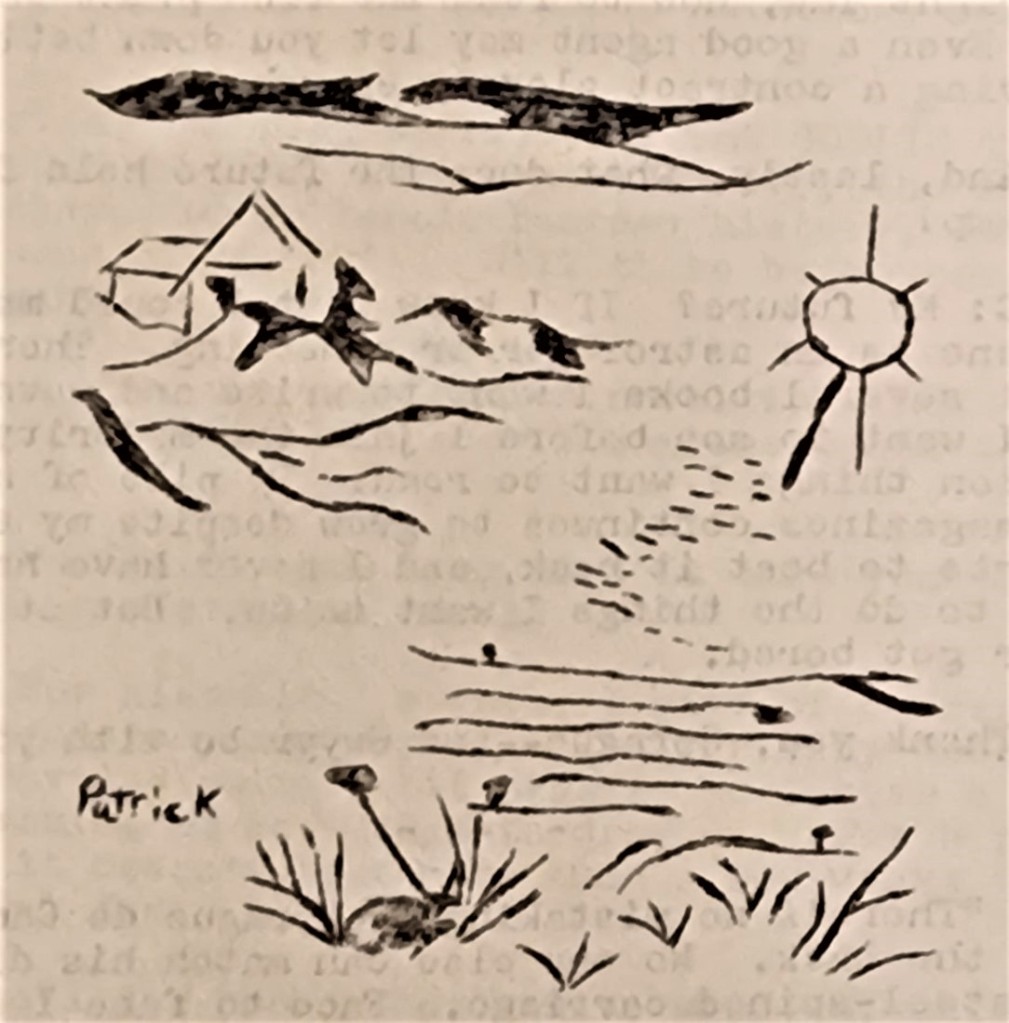

“Wayfarers (with usual apologies to W. S. Gilbert)” (L. Sprague de Camp). PR1: page 16; PR2: page 25.
Appears in both issues. In PR1, the third de Camp poem featured; in PR2, it is moved ahead of the others to become the first. Also referred to as “The Wayfarers” in PR1’s table of contents and reprint data, and in PR2’s reprint data as well. Another parody. De Camp did a number of Gilbertian take-offs over the years, and in this instance, he spoofs Lord High Executioner Ko-Ko’s “I’ve Got a Little List” song from The Mikado. De Camp’s own list of people who would “not be missed” is of “obnoxious fellow tourists” encountered in his more organized (that is, guided) travels. Comparison with the tourist characters in his Krishna novel The Hostage of Zir (1977) is instructive. The poem is copyrighted 1974, and Hall’s “Reprint Data” in PR1 informs us it “is printed here for the first time—information which, combined, provides our sole in-issue evidence that PR1 as a whole was published in 1974. The poem would later be reprinted in de Camp’s verse collection Heroes and Hobgoblins (1981).
“The Hippopotamus” (L. Sprague de Camp). PR2: page 31.
Appears in PR2 only, where it is the fourth poem by de Camp. An amusing versification of his well-known anecdote on being pursued by a hippo in Uganda. Hall’s “reprint data” correctly places its original appearance, in Phantoms & Fancies (1972). Its next appearance was here, and it would later reappear in Heroes and Hobgoblins (1981).
“Ghost” (L. Sprague de Camp). PR2: page 32.
Appears in PR2 only, where it is the fifth poem by de Camp. In two longish stanzas, de Camp tells of ghosts as imagined in former times, and in the present—but his present-day ghosts are the shadows of early twentieth century folk, as captured on old newsreels. He ends speculating on how people today may likewise become recorded ghosts in the future. An evocative and wistful poem. Hall’s “reprint data” correctly sources this one to The Arkham Collector, no. 5, summer, 1969; it also appeared in Demons and Dinosaurs (1970) and Phantoms & Fancies (1972) prior to its PR2 reprinting, and would later reappear in Heroes and Hobgoblins (1981).
“Night” (L. Sprague de Camp). PR2: page 33.
Appears in PR2 only, where it is the sixth and last poem by de Camp. The verse paints a picture of night terrors afflicting the perturbed poet, and ends with an uncharacteristic prayer: “O God, in whom I really don’t believe, / Preserve me until day!” An effective piece, that simultaneously manages to achieve an atmosphere of both dread and whimsy, and some dynamite imagery. You have to love a fellow who can bring off lines like “The house complains with creaks and groans. The moon / Throws mist minnows on the chiffonier, / And, shrinking as they cool, the timbers groan.”
This poem proved oddly elusive bibliographically to both Hall and Laughlin & Levack. Hall managed to omit it from PR2’s table of contents, despite having just sourced it to The Arkham Collector, no. 3, summer 1968 in his “reprint data.” In Laughlin & Levack we learn it also stopped over in Demons and Dinosaurs (1970), and Phantoms & Fancies (1972) before appearing in PR2, but they are unaware it did appear in PR2, misled, perhaps, by Hall’s contents omission. This piece would not later reappear in Heroes and Hobgoblins; its printing here represents its latest appearance to date.
“De Camp” (Tim C. Marion). PR1: page 37; PR2: page 28.
Appears in both issues. A short fan tribute poem, Marion’s piece is pedestrian, but has the distinction that its six lines form an acrostic, the first letter of each, read top to bottom, spelling out “DE CAMP.” The versifier himself is more interesting than his verse. Timothy C. Marion (b. 1958) was a prominent spec fiction fan in the 1970s, publisher of numerous fanzines and a founder of the amateur press association REHUPA, the Robert E. Howard United Press Association, in 1972. In the 1980s his interest turned to comics. He is currently one of the administrators of the Facebook de Camp group L. Sprague de Camp- Enchanter of the Quill.
In PR1 this was a random bit of filler, inserted after the Gillam article that concluded the review section; in PR2 it was augmented by two similar short pieces to make a page of fan tribute verses to de Camp. This was the interloping page that spoilt the double page spread of “Spring.” The authors were fans of note, either at the time or later, but their efforts fall short of the company they keep in the zine. I’m not sure what Hall was thinking by expanding what should have been a one-off short into its own mini-category.
In PR2 the poem is accompanied by an unattributed illustration of a flaming head.
“For Sprague” (W. H. Pugmire). PR2: page 28.
Appears in PR2 only. The second de Camp tribute poem. It imitates the “Eldritch Yankee Gentleman” style of H. P. Lovecraft, and celebrates de Camp’s authorship of the Lovecraft biography. Rhymes but lacks scansion, and of little distinction. Once again, the poet is more interesting than the poem. W. H. Pugmire, was born William Harry Pugmire and later officially redubbed himself Wilum Hopfrog Pugmire (the middle name comes from the Poe short story “Hop-Frog”). He is a Lovecraft enthusiast and prolific author of Lovecraftiana, called by J. T. Joshi “the prose-poet of the horror/fantasy field; he may be the best prose-poet we have.” In this early verse Pugmire was seemingly still finding his legs.
The poem is accompanied by an illustration of a smiling, odd-looking frog (its face merged with its body, and with a long tail). Also unattributed, though it bears the “M” signature encountered earlier. Possibly an in-reference to Pugmire’s assumed middle name.
“A Limerick” (Loay Hall). PR2: page 28.
Appears in PR2 only. The third de Camp tribute verse. A properly constructed and technically correct limerick, positing an affair between Gezun of Lorsk, hero of several of de Camp’s Pusadian tales, with his own cousin, an intrigue discovered by Gezun’s wife Ro. The subject matter, while appropriate for a limerick, does not fit the characters as presented by de Camp, and strikes me as dull and humorless.
Accompanied by an unattributed illustration of a smiling creature in profile, captioned “Gezun’s cousin??”
“A Sick de Camp Pun.” PR1: page 12.
Appears in PR1 only. A minor, negligible contribution; unlike with the non-de Camp verse, Hall did not see fit to give puns a full page in PR2, so we’re left with this singular instance. More bottom-of-page filler, attributed in the contents to “Anonymous.” Not really sick, just obvious; in full, it reads “A funny thing happened on the way to see Sprague: he up and decamped!”
END PIECE.
“The Viagens Interplanetarias” (Sheryl Birkhead). PR1: page 44; PR2: page 40.
One item remains to discuss; the end-of-issue illustration previously mentioned twice above, which appeared after Lin Carter’s de Camp tribute in PR1, and Sandra Miesel’s review of Great Cities of the Ancient World in PR2, in both instances because they were the last pieces in their respective issues. Credited on page ii of PR1 to Sheryl Birkhead, this one is evidently a spaceship under propulsion, though it looks more like a rough flint arrowhead, only the flames at the base end and the inscribed name “the Viagens Interplanetarias” indicating otherwise. The version appearing in PR2 is slightly modified.
OVERALL ASSESSMENT.
We can now assess Pusad Revisited as a whole. To reiterate, over the two issues, a core of fifteen pieces appeared in both; the introduction, the interview, seven professional or fan tributes, three de Camp poems, two book reviews, and the Marion poem. Hall’s interview of de Camp is valuable. The tributes are fun and sometimes insightful; Hall’s efforts in securing and printing them is a service to de Camp scholarship. The reviews are decent. Of the pieces by de Camp himself, the introduction is gracious if lightweight, and the poems nice to see, though available elsewhere. Hall scored a coup in providing the original publication venue for “Wayfarers.” By and large, a good assortment. Only the Marion poem doesn’t belong.
Seven pieces did not make the jump from PR1 to PR2; the Hall and Carter tributes, the reviews of A Gun for Dinosaur, “The Emperor’s Fan,” and Conan the Buccaneer, the Gillam review article, and the “sick pun.” This batch is a mixed bag, containing some of the strongest and weakest material in PR1. The best are the Gillam article, Hall’s tribute, and the A Gun for Dinosaur review. Gillam’s in-depth examination of de Camp’s fiction, in particular, is extraordinary. Of the remaining pieces, the Carter tribute is minor, and can be found elsewhere. The Conan the Buccaneer review is interesting, but schizophrenic; the reviewer applied to the book two standards of worth, which failed to mesh. “The Emperor’s Fan” review is puzzling; Hall didn’t like the story and said so, but failed to support his opinion. There is no excuse for the “sick pun.”
Seven new pieces came into the mix in PR2, with Sawyer’s compilation from de Camp’s letters, three additional de Camp poems, one book review, and two non-de Camp poems taking the place of the material dropped after PR1. They are generally shorter and less weighty than the pieces they replace, though the Sawyer piece is excellent, Hall’s Lovecraft: A Biography review a worthy addition, and the added de Camp poems welcome, though they, too, can be found elsewhere. There really wasn’t any decent reason for adding the two non-de Camp poems. Nonetheless, PR2, in some ways represents an advance; leaner, better organized, and with more art than its predecessor.
There is much here to delight any de Camp fan. In my reckoning, about nineteen good to excellent pieces and five okay to good ones, with just five subpar. The Pusad Revisited material deserves a wider readership than, at this late date, it is likely to get. I hope this in-depth exploration can provide at least a taste of its worth.
In conclusion, it might not be amiss to note that, were PR a book, it would have much in common with the de Camp miscellanies Scribblings (1972) and Footprints on Sand (1981), both of which also brought together pieces by the Master in various genres, and the latter of which also gathered in tributes from other hands, some of which first appeared in Hall’s pair of fanzines. Hall’s work may, indeed, even have set the pattern for the second miscellany. He certainly brought together enough professional-grade material to enable Pusad Revisited to stand proudly alongside these other works.
SO WHY PUSAD?
One more question may well occur to the reader. Why did Hall dub his pair of fanzines Pusad Revisited? It’s not a bad choice; the Pusadian tales did make up de Camp’s earliest solo fantasy series, critically applauded in the 1950s as a more accomplished foray into the Howardian-type tale than those of Howard himself (however odd that assessment may sound to modern ears). The series would have stood out prominently in the minds and imaginations of his earlier fans, so the notion of a fanzine devoted to de Camp in general and Pusad in particular would have been a natural one.
But … why say you’re revisiting Pusad when you’re not actually revisiting Pusad? Pusad Revisited has nearly no Pusad in it—not in de Camp’s introduction, nor in Sawyer’s excerpts from de Camp’s letters, the professional tributes, or the de Camp poems. None of the book reviews concern it. Aside from the title, it’s not even on the covers, which are instead taken over, front and back, by “A Gun for Dinosaur.” Only Hall’s interview of de Camp and Gillam’s review article mention Pusad even in passing, and the only piece actually devoted to it is Hall’s limerick. De Camp’s biography of H. P. Lovecraft, contemporaneous with the two PR issues, receives much more wordage than Pusad. What gives here?
My guess is that Hall assumed more of his contributors might want to discuss it than actually did. In the event, even he showed little interest in dragging it in. It’s a mystery.
WRAPPING UP.
At this point, I would normally hold forth on the seven people to whom the two issues of the publication were dedicated, but in this instance you should already know about de Camp (or you wouldn’t be here), while Jim Garrison, Sandra Miesel, Barry Gillam, Phillip Sawyer, and Terry Lee Dale have already been discussed as contributors, and Hall has already identified the late Dorothy Steele as his sister; further, we need not pry.
My personal thanks to Gary Romeo, without whose scans of PR1 this article would have been posted a lot sooner, but have been a lot shorter. This one’s been long, but fun!




